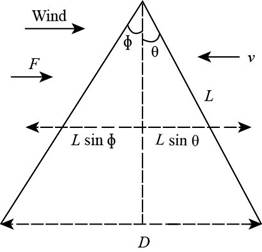
Concept explainers
(a)
The minimum speed of the swing with which Jane must begin her swing to just make it to the other side.
(a)
Answer to Problem 8.81CP
The minimum speed of the swing with which Jane must begin her swing to just make it to the other side is
Explanation of Solution
Given info: The mass of Jane is
The diagram is shown below.

Figure I
From the figure, the width of the river is,
Here,
Rearrange the above formula for
Substitute
Thus, the value of
The formula to calculate the initial kinetic energy of Jane is,
Here,
Thus, the initial kinetic energy of Jane is
The formula to calculate the final kinetic energy of Jane is,
Here,
Substitute
Thus, the final kinetic energy of the Jane is
The formula to calculate the initial gravitational potential energy is,
Here,
Thus, the initial gravitational potential energy is
The formula to calculate the final gravitational potential energy is,
Here,
Thus the final potential energy of the car is
The formula to calculate the initial work done of the wind due to constant force is,
Here,
Substitute
Thus, the initial work done of the wind is
The formula to calculate the law of conservation of energy to the total system is,
Here,
Substitute
Substitute
Conclusion:
Therefore, the minimum speed of the swing that must Jane begin her swing to just make it to the other side is
(b)
The minimum speed of the swing at the beginning.
(b)
Answer to Problem 8.81CP
The minimum speed of the swing at the beginning is
Explanation of Solution
Given info: The mass of Jane is
The formula to calculate the combined mass is,
Here,
Substitute
The formula to calculate the initial kinetic energy is,
Here,
Thus, the initial kinetic energy is
The formula to calculate the final kinetic energy of Jane is,
Here,
Substitute
Thus, the final kinetic energy is
The formula to calculate the initial gravitational potential energy is,
Here,
Thus, the initial gravitational potential energy is
The formula to calculate the final gravitational potential energy is,
Here,
Thus the final potential energy of the car is
The formula to calculate the initial work done of the wind due to constant force is,
Here,
Substitute
Thus, the initial work done of the wind is
The formula to calculate the law of conservation of energy to the total system is,
Here,
Substitute
Substitute
Conclusion:
Therefore, the minimum speed of the swing at the beginning is
Want to see more full solutions like this?
Chapter 8 Solutions
Physics for Scientists and Engineers (AP Edition)
- Identical rays of light enter three transparent blocks composed of different materials. Light slows down upon entering the blocks.arrow_forwardFor single-slit diffraction, calculate the first three values of (the total phase difference between rays from each edge of the slit) that produce subsidiary maxima by a) using the phasor model, b) setting dr = 0, where I is given by, I = Io (sin (10) ². 2arrow_forwardA capacitor with a capacitance of C = 5.95×10−5 F is charged by connecting it to a 12.5 −V battery. The capacitor is then disconnected from the battery and connected across an inductor with an inductance of L = 1.55 H . (D)What is the charge on the capacitor 0.0235 s after the connection to the inductor is made? Interpret the sign of your answer. (e) At the time given in part (d), what is the current in the inductor? Interpret the sign of your answer. (f) Atthe time given in part (d), how much electrical energy is stored in the capacitor and how much is stored in the inductor?arrow_forward
 Principles of Physics: A Calculus-Based TextPhysicsISBN:9781133104261Author:Raymond A. Serway, John W. JewettPublisher:Cengage Learning
Principles of Physics: A Calculus-Based TextPhysicsISBN:9781133104261Author:Raymond A. Serway, John W. JewettPublisher:Cengage Learning Physics for Scientists and Engineers: Foundations...PhysicsISBN:9781133939146Author:Katz, Debora M.Publisher:Cengage Learning
Physics for Scientists and Engineers: Foundations...PhysicsISBN:9781133939146Author:Katz, Debora M.Publisher:Cengage Learning College PhysicsPhysicsISBN:9781285737027Author:Raymond A. Serway, Chris VuillePublisher:Cengage Learning
College PhysicsPhysicsISBN:9781285737027Author:Raymond A. Serway, Chris VuillePublisher:Cengage Learning Physics for Scientists and Engineers with Modern ...PhysicsISBN:9781337553292Author:Raymond A. Serway, John W. JewettPublisher:Cengage Learning
Physics for Scientists and Engineers with Modern ...PhysicsISBN:9781337553292Author:Raymond A. Serway, John W. JewettPublisher:Cengage Learning College PhysicsPhysicsISBN:9781938168000Author:Paul Peter Urone, Roger HinrichsPublisher:OpenStax College
College PhysicsPhysicsISBN:9781938168000Author:Paul Peter Urone, Roger HinrichsPublisher:OpenStax College Physics for Scientists and Engineers, Technology ...PhysicsISBN:9781305116399Author:Raymond A. Serway, John W. JewettPublisher:Cengage Learning
Physics for Scientists and Engineers, Technology ...PhysicsISBN:9781305116399Author:Raymond A. Serway, John W. JewettPublisher:Cengage Learning





